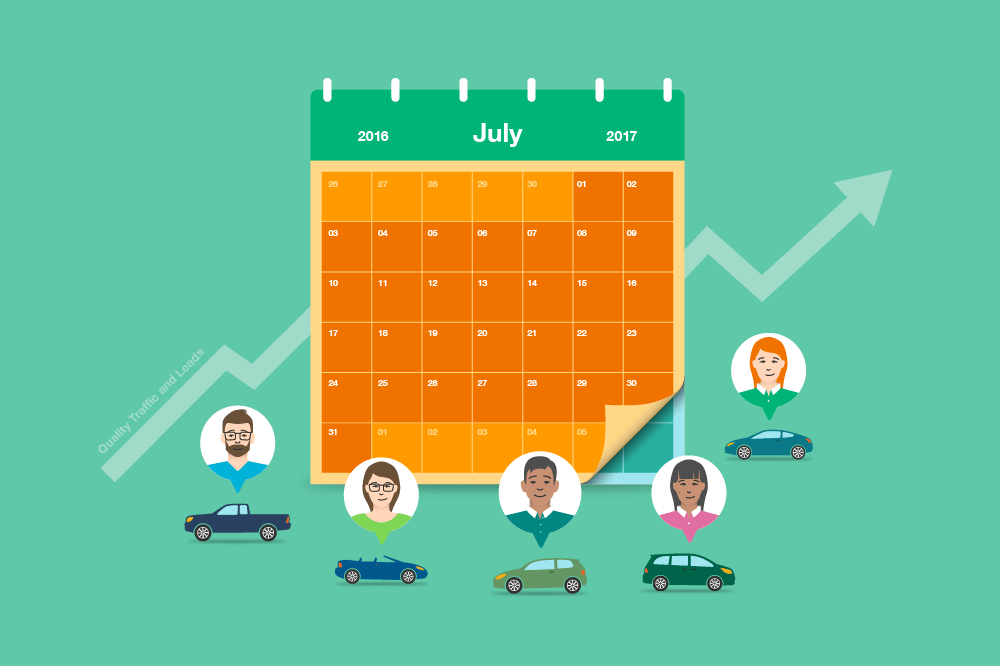Forget the fireworks in the sky; the real fireworks can be found online.
The Fourth of July weekend is a consistently strong holiday weekend for online car shopping activity. Last year, visits to websites were up 56 percent and vehicle details page (VDP) views were up 48 percent compared to other January to July weekends. In 2016, the holiday weekend strongly outpaced last year’s results, with website visits up 73 percent and VDP views up 63 percent compared to other weekends this year.
Despite that strong start to the month, however, dealers should be aware that online shopping behavior in July is showing warning signs of a slowdown in growth.
During July 2016, website visits were up eight percent compared to July 2015, an incredibly modest increase compared to last July, when website visits rose 22 percent from the previous year. The data for VDP views is even more sobering, with an eight percent increase this year compared to a huge 63 percent increase the previous year.
Digging into the data a little deeper shows that new car shopping activity is slowing more than used car activity. New car VDP views crept up 1.2 percent in July 2016 compared to last year, while used vehicle VDP views are up 13 percent year-over-year.
Paid search cost-per-click (CPC) is a good way to measure the market for digital advertising since it tends to follow the basic laws of supply and demand. In general, CPC is up year-over-year in 2016, indicating that the same level of exposure, also known as impression share, is more expensive this year than it was last year. For July 2016, CPC is up nine percent compared to last year. CPC, however, is down three percent from June 2016, which indicates a slight decrease in competition for digital advertising real estate.
What does this mean for dealers?
Ultimately, it’s best to focus on the quality of your digital marketing activity rather than the quantity. An overall slowdown in the market will mean more competition for each and every sale. It also means that we shouldn’t continue to expect high growth in numbers of visits, VDP views, form submissions, etc. Instead, we need to focus on improving the quality of the traffic flowing to your websites.
How do you do that? Here are four practical things you should consider as the summer comes to a close.
1. Benchmark the quality of your digital marketing.
One of the most important things you can do is benchmark the quality of your digital marketing against your competition.
Dealer.com Analytics feature benchmarking tools that give you access to 180 different comparisons measures, so you can see how your performance sizes up to the competition.
For example, use the Referral Details report to look at your organic search traffic. Turn on the “Dealers Like Me” benchmark to see how your organic search results compare to others in your benchmark set. If you’re not happy with where you stack up, look at your SEO strategy.
2. Look for opportunity to strengthen your digital advertising.
Digital advertising is a great way to attract quality, in-market shoppers to your website. Slightly reduced CPC indicates there may be an opportunity for dealers to expand their advertising footprint for less and capture additional impression share, or add a campaign that’s not currently in your portfolio. Your Dealer.com Analytics reporting can help you understand if you’re seeing a reduced CPC in your area, and your Dealer.com advertising strategist can help you put together a plan to capitalize on this opportunity.
3. Consider your content.
A disciplined content strategy is critical to both attracting and retaining online car shoppers, especially as the market starts to get more competitive. Not only does high-quality content – whether its inventory descriptions, blog posts, or even “about us” page descriptions – keep online shoppers engaged, it keeps your website search engine-optimized. Algorithms reward content that is useful to actual people.
Think “Resources” instead of “Landing Pages.” For example, a custom page comparing one of your bestselling models to its competition would be incredibly valuable to customers, and would be rewarded by search engines with a stronger search ranking, thus helping you attract more customers through organic search and keep them engaged with your dealership’s high-quality website experience.
4. Focus on a used car strategy.
With new car VDP views slowing down more than those of pre-owned, and a growing number of vehicles coming off lease, you can expect more used car activity in your dealership in the coming months.
Review your ad strategy to ensure you’re working toward an optimal new/used inventory digital advertising balance, especially with the potential for discounted advertising real estate.
The reasons for the digital traffic slow down are up for debate. But one thing is for certain: demand for vehicles is cyclical. Demand can fluctuate seasonally or yearly. It’s the nature of the business. The key to smooth out the bumps, however, is to focus on attracting high-quality, motivated traffic to your website.
James Grace is Director of Analytics Product Management at Dealer.com
